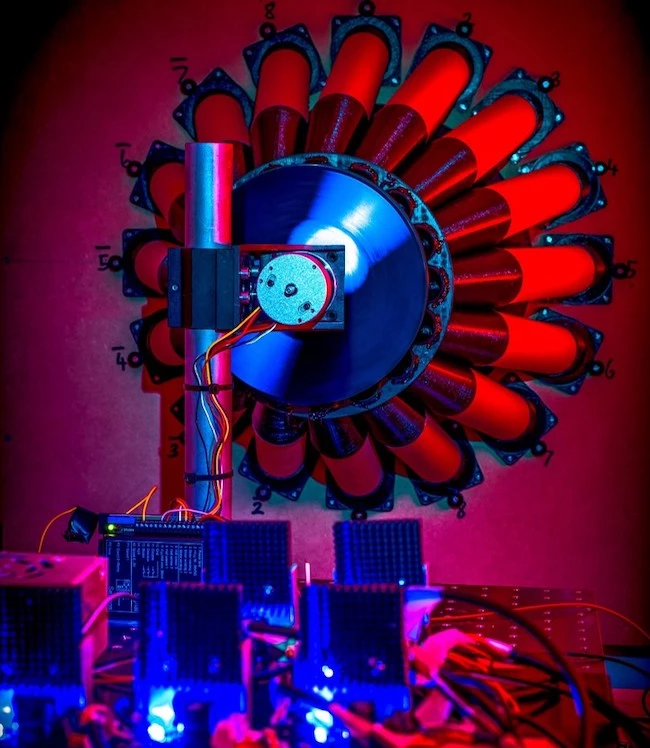Scientists at the University of Glasgow have confirmed a half-century-old theory that claimed a super-advanced alien civilization could use a black hole as an energy source. By using sound waves, the researchers were able to conduct an experiment on the phenomenon that was previously thought beyond the scope of human engineering to test.
The idea of harnessing a black hole as an energy source may sound like something out of a 1970s Doctor Who episode, but it's actually based on some solid physics. In 1969, British physicist Roger Penrose was exploring the properties of still-theoretical black holes and found that they had a practical application – if you happened to be a member of a super-advanced race of alien beings.
Penrose theorized that if you took an object and lowered it into the outer region of a black hole's event horizon, it would have to move at the speed of light just to remain still. As it's lowered, it acquires negative energy. That is, it is subjected to very special space-time conditions where, to put it very simply, it is possible to "borrow" energy from empty space.
The clever bit, according to Penrose, is that if the object is then split in two, with one half falling into the black hole and the other recovered, the recoil would cause a loss of some of this negative energy and the recovered half would gain energy from the black hole's rotation. Needless to say, mucking about with black holes would involve engineering on a fantastic scale, so only a highly advanced civilization would have a chance of pulling off such a project.

The fly in the ointment came in 1971, when Soviet physicist Yakov Zel'dovich came up with an experiment involving twisted light to prove Penrose's concept.
Twisted light is when a beam of light twists around its wavefront to the point it takes on a helical or "twisted" shape about its empty core. Zel'dovich said that if a twisted light beam was aimed at a metal cylinder spinning at the right speed, the reflected beam would pick up energy taken from the cylinder's rotation due to an oddity in the rotational Doppler effect. The annoying part is that it would require the cylinder to rotate over a billion times a second, which puts us back into alien engineering territory.
This is where matters stood for almost 50 years, until a team of scientists from the University of Glasgow’s School of Physics and Astronomy led by Marion Cromb did a bit of lateral thinking. Instead of using twisted light, they reasoned, why not use twisted sound, which works on a much lower frequency and around which an experiment could be designed that could actually be built by us mere humans.
What they did was to set up a small ring of speakers to create the twisted sound waves. These waves were then aimed at a rotating sound absorber made from a foam disc. Meanwhile, microphones behind the disc measured the frequency and amplitude of the waves after passing through the increasingly faster spinning disc to see if the rotational Doppler effect would tally with Penrose and Zel'dovich's theories.
In this case, the spin of the disc decreased the pitch of the sound, dropping it until it became inaudible, then it rose back to its previous pitch, only the amplitude was 30 percent greater than what was originally emitted from the speakers.
"The linear version of the Doppler effect is familiar to most people as the phenomenon that occurs as the pitch of an ambulance siren appears to rise as it approaches the listener but drops as it heads away," says Cromb. "It appears to rise because the sound waves are reaching the listener more frequently as the ambulance nears, then less frequently as it passes.
"The rotational Doppler effect is similar, but the effect is confined to a circular space. The twisted sound waves change their pitch when measured from the point of view of the rotating surface. If the surface rotates fast enough then the sound frequency can do something very strange – it can go from a positive frequency to a negative one, and in doing so steal some energy from the rotation of the surface.
"What we heard during our experiment was extraordinary. What’s happening is that the frequency of the sound waves is being Doppler-shifted to zero as the spin speed increases. When the sound starts back up again, it’s because the waves have been shifted from a positive frequency to a negative frequency. Those negative-frequency waves are capable of taking some of the energy from the spinning foam disc, becoming louder in the process – just as Zel’dovich proposed in 1971."
The research was published in Nature Physics and the experiment is described in the video below.
Source: University of Glasgow





